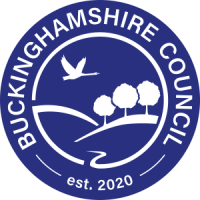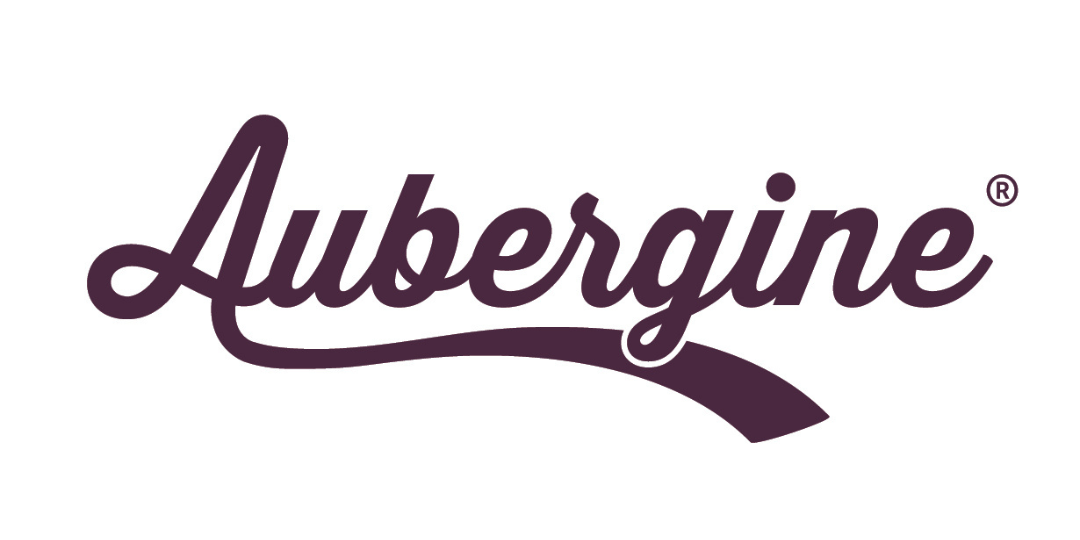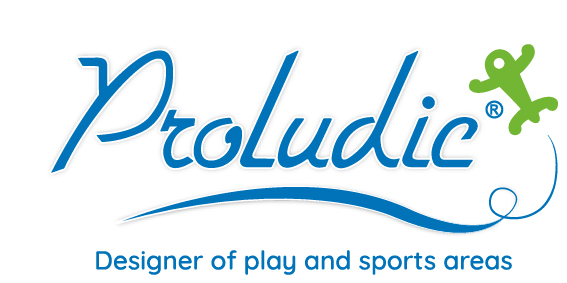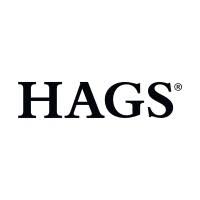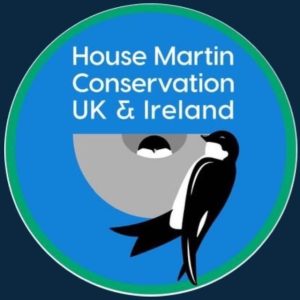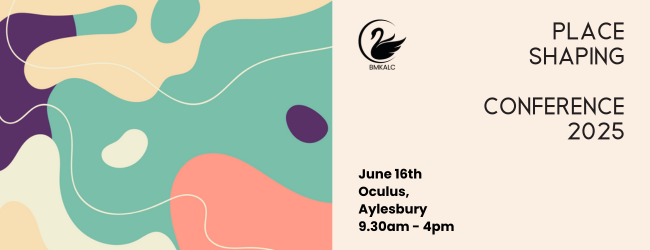
Conference 2025
Oculus The Gateway Conference Centre, Gatehouse Rd, Aylesbury, HP19 8FF
We are pleased to announce our Conference for 2025 on the topic of Place Shaping. The concept of place shaping calls on us to shape our place, it’s an invitation to take charge of our local areas, to mould them into shapes that not only appeal to us, but also to those who visit or invest in our communities. It’s about re-imagining our surroundings and painting a new, vibrant picture of our area, it’s about creating spaces and environments that are better for everyone.
What’s Happening?
We will explore the narratives of ‘place’, the social and physical fabric of the communities in which people live, their collective experience of urban environments, high streets, town centres and rural areas. ‘Places’ are economies where we earn our living, communities where we relate to others, and the centrepiece of our identity and belonging.
What Is Place Shaping?
Shaping our Place Understanding your parish’s Unique Selling Proposition (USP) is vital in setting it apart from over 9,000 other alternatives. Mel Woof’s introduction to the concept of “Shaping your Place” underscores the necessity of identifying and effectively communicating what makes your parish exceptional. A compelling USP not only showcases the unique features and benefits of your parish but also aligns with the needs and desires of your residents, both existing and prospective. By emphasizing what makes your community special, from historical landmarks to vibrant local events, you can attract new families and strengthen the communal bond. Knowing your parish’s identity, offerings, and future direction enables you to share a cohesive and inspiring vision, fostering a thriving and unified community.
Shelter
The bones of our communities are intricately formed by a synergy of planning, design codes, economic or energy security, climate management, and biodiversity. Thoughtful urban planning ensures that spaces are functional, efficient, and conducive to social interaction. Design codes enforce aesthetic and structural standards that preserve a community’s character and safety. Economic and energy security provide the backbone for sustainable growth, ensuring that resources are managed wisely and communities are resilient against economic shocks and energy crises. Climate management is crucial in mitigating the adverse effects of global warming, with proactive measures to reduce carbon footprints and enhance environmental sustainability. Biodiversity enriches our ecosystems, promoting balance and resilience within natural habitats. Together, these elements create a robust framework that fosters thriving, sustainable, and harmonious communities.
Security
Security in place-shaping is a multifaceted concept that encompasses physical safety, economic stability, and structural integrity. At its core, it involves designing and managing environments in a way that mitigates risks and fosters a sense of safety and well-being among residents. Physical safety is addressed through measures such as effective urban planning, adequate lighting, surveillance systems, and emergency response strategies. Economic security is promoted by creating job opportunities, supporting local businesses, and ensuring access to essential services. Structural security ensures that buildings and infrastructure are resilient to natural disasters, wear and tear, and other potential hazards. By integrating these elements, place-shaping not only enhances the quality of life but also builds a resilient and thriving community.
Food
Food is a multifaceted entity, encompassing both physical sustenance and cultural significance. Its availability hinges on numerous factors, including geographical location, seasonal variations, and socio[1]economic conditions. The concept of “food miles” highlights the distance food travels from production to consumer, influencing its environmental impact and freshness. Choices in food can range from mass-produced items to artisanal products, which often emphasise quality, tradition, and local ingredients. Affordability remains a critical aspect, as it determines access to nutritious options for diverse populations. Ultimately, food is a complex interplay of physical necessity and cultural identity, shaped by global and local dynamics.
Warmth
Warmth in our communities extends beyond the physical shelter that provides protection from the elements; it also encompasses the emotional and social support that fosters a sense of belonging and security. When we consider the concept of “place,” it is essential to think of it holistically, recognizing the community’s role in nurturing individuals from cradle to grave. A supportive community offers more than just a physical space; it provides a network of care, mutual aid, and shared values that enhance the quality of life for all its members. This sense of belonging and connection is crucial for personal development, mental health, and overall well-being, making the warmth of a community an invaluable aspect of a fulfilling life
Book Tickets
Members Tickets £25 per delegate
Non-members Tickets £50 per delegate
Book Workshops
At the conference there will be three workshops on during the afternoon session. These are for limited numbers of participants. All workshops are running simultaneously so please book onto your preferred workshop using the links below:
Bookings for the FREE workshops are only available to attendees of the conference with a valid event ticket.
BOOKING FOR WORKSHOPS NOW OPEN!
Exhibitors
- BUCKINGHAMSHIRE COUNCIL
- HERITAGE & ARCHAEOLOGY
- NEP
- THE PARKS TRUST
- AUBERGINE
- CCLA
- NATIONAL ALLOTMENT SOCIETY
- EXTENDED STUDIO
- BREAKTHROUGH COMMUNICATIONS
- ONH
- BLACHERE ILLUMINATIONS
- HAGS
- PROLUDIC
- COMMUNITY IMPACT BUCKS
- AT CREATIVE
- CENTRE FOR AGING BETTER UK
- MKCC
- The MAYORS BEAR
- BUCKS DATA EXCHANGE
- BUCKINGHAMSHIRE ARCHIVE
Programme

Countess Howe President of BMKALC
![]()

Mel Woof, CEO, BMKALC
![]()

Matthew Barber
The PCC’s role is to hold the Chief Constable of Thames Valley Police to account for the performance of the Force, effectively making the police answerable to the communities they serve. The PCCs also has a wider role in promoting community safety and working with criminal justice partners to improve support for victims of crime.
Matthew is joint lead for Serious Violence at the Association of Police & Crime Commissioners and is also a Director of Blue Light Commercial and the National Business Crime Solution.
Matthew was raised and schooled in Oxfordshire before graduating from Brunel University. He still lives in Oxfordshire, is married to Katie and has two children, Emily and Lucy; and a labrador!
Matthew is Police & Crime Commissioner (PCC) for Thames Valley, covering Berkshire, Buckinghamshire, Milton Keynes and Oxfordshire. Elected to the role in May 2021 with a majority of nearly 80,000. He served as Deputy PCC from 2017 to 2021, during which time he took on the chairmanship of the Local Criminal Justice Board.
Matthew also served as a councillor in the Vale of White Horse for nearly nineteen years. First elected to the Council in 2003 he served as Leader from 2011 to 2018 before standing down in March 2022. He has been a director of the Oxfordshire Local Enterprise Partnership as well as founding Chairman of Vale4Business and a Board Member of Science Vale and is involved in various charitable organisations.
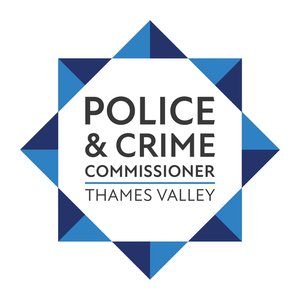
This talk will set out how local communities can find out more about their local heritage and archaeology and understand the evolution of their settlements. We will look at the importance of Conservation Areas and Local Heritage Listing, and how they add value to a place. We will also discuss heritage-led regeneration and look at examples of where this has worked.
Speakers:
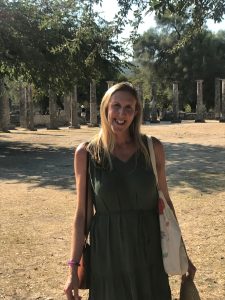
Eliza Alqassar – Historic, Built and Natural Environment Manager, Buckinghamshire Council
Bio: Eliza Alqassar studied archaeology at the University of Exeter and completed a Masters in Field Archaeology at the University of York. She worked for York Archaeological Trust as a digger and Community Archaeologist before lecturing in Archaeology at the University of Winchester.
From there she joined the Historic Environment Team at Cambridgeshire County Council before becoming the Archaeology Officer at Buckinghamshire County Council. Eliza also spent two years as an Assistant Inspector of Ancient Monuments with Historic England SE team, which she did alongside her role in Buckinghamshire. Eliza now manages the heritage, archaeology, ecology, arboriculture and Environmental Record Centre teams at Buckinghamshire Council.
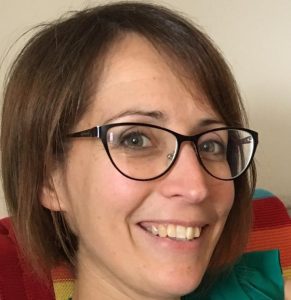
Lucy Lawrence – Archaeology Officer, Buckinghamshire Council
Bio: Lucy Lawrence (nee Norman) studied archaeology and classical civilisation at the University of Nottingham. After graduating in 2000 and two years living abroad, she started work for Wessex Archaeology at the Heathrow Terminal 5 excavations. Following this she transferred to Oxford Archaeology where she spent 12 years, initially working in the field, before moving into their in-house consultancy team. In 2015 she joined Cotswold Archaeology as part of the Milton Keynes consultancy department. Lucy joined Buckinghamshire County Archaeology Service in 2018.


Will Rysdale B.A. (Hons) CIHCM – Head of Housing Delivery and Regeneration
Will is a qualified housing professional with over 20 years’ experience working for local authorities. He is currently responsible for leading on MKCC’s delivery of new council homes and regeneration aspirations including the regeneration of the Lakes Estate. In previous roles Will was an Assistant Director for a large district council, having responsible for a wide range of services including homelessness and allocations, strategic planning, community safety and waste and recycling.
Will Ryesdale

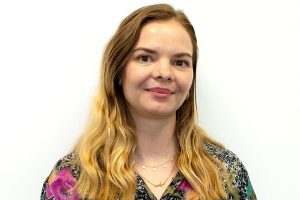
Bio: Bianca Rossetti is Centre for Ageing Better’s Strategic Partnership Manager, based in Greater Manchester. Bianca is a member of the Centre’s Localities team, which encourages and supports places to adopt approaches that focus on older people and ageing to improve population health, reduce inequality and benefit local economies. Having worked on programmes focused on older people for the past decade, Bianca is passionate about place-based, collaborative approaches to improving people’s experience of later life, and challenging myths around demographic ageing.
About Centre for Ageing Better: The Centre for Ageing Better is pioneering ways to make ageing better a reality for everyone. This includes challenging ageism and building an Age-friendly Movement, creating Age-friendly Employment and Age-friendly Homes. It is a charitable foundation funded by The National Lottery Community Fund and part of the government’s What Works Network.


Matthew Harmsworth Bio:
Matthew is a multi-award winning, RTPI chartered Social Value and Town Planning consultant wide ranging local authority, developer and consultancy side experience with university degrees in Psychology, Audiology, and Town Planning. He is Arcadis’ Global Chair for Access and Neurodiversity, providing strategic oversight of this across the business. He is also a co-lead of the UK’s Neurodiversity in Planning Network. Matthew has an extensive range of experience across residential, employment, health, and infrastructure development projects.
Arcadis put quality of life at the heart of placemaking and regeneration; And, with the acquisition of IBI Group and CRTKL, is recognised as one of the largest and most successful built and natural environment design practices in the world. Placemaking at Arcadis takes shape through a broad multidisciplinary approach to creating thriving communities through holistic human-centric, sustainable, innovative, technology-led and nature-integrated design solutions led by world class specialist teams.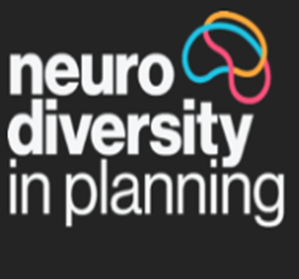

Dan will explore how effective communication and meaningful community engagement are vital tools for shaping vibrant, resilient places. During this 15 minute talk he will share practical insights on how to harness strategic messaging, storytelling, and two-way dialogue to build trust, foster local identity, and empower communities to play an active role in shaping the future of their area.

Dan Purchese , Director, Breakthrough Communications
Breakthrough Communications, who provide local councils with advice, support and guidance relating to council communications and community engagement, as well as for council data protection and Freedom of Information. Their experienced team is ready to help your council communicate effectively and compliantly with your community.
Communications, community engagement and data protection services for parish and town councils
Breakthrough Communications’ community engagement services include creating communication and community engagement strategies, creating and managing neighbourhood plans and community surveys, and providing social media support and advice. They support councils with crisis communications situations. Breakthrough Communications data protection services include carrying out council-wide data map audits, data protection impact assessments, and creating and refreshing data protection policies and procedures.
Council Hive service for parish and town councils
Council Hive is a subscription service that empowers parish and town councils to communicate effectively and compliantly with their communities. Council Hive takes the stress out of local council communications and compliance, saving clerks and council officers time, effort and money. Council Hive provides Clerks and council officers access to expert communication and compliance advice, templates, resource packs, and masterclasses – all in one place. Discover more at https://breakthroughcomms.co.uk/hive.

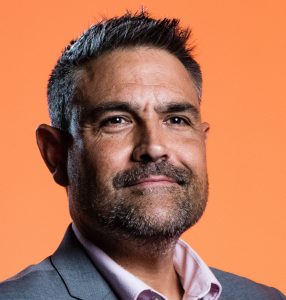
Mark Tomkins, website accessibility & .gov.uk expert | Aubergine
In today’s connected world, “place” is no longer just physical — it’s also digital. This session explores how town and parish councils can lead in shaping both. From websites as digital town or village halls to the debut of Helen AI, a virtual assistant designed to support council clerks, attendees will see how embracing digital tools can enhance accessibility, transparency, and community engagement. Discover how modern councils can turn their websites into 24/7 community hubs — and how AI is making local governance smarter, not harder and help shape YOUR place.
💡 Key Takeaways:
• Why accessible, well-designed websites are essential digital places
• How councils can use AI to save time and serve residents better
• A vision for digital place shaping that complements physical community building
Aubergine are one of the UK’s leading experts in providing fully compliant websites meeting both WCAG2.1AA (and WCAG2.2AA from October when the requirements change) alongside being authorised to register and manage.gov.uk domains.
We’re the official partner of SLCC for compliant websites and authors of the NALC Website Accessibility & Publishing Guidebook and are helping many parishes and towns migrate their websites over to a new, modern platform that’s easy to use, mobile friendly and fully compliant with Transparency Code and Accessibility requirements.

Full list of panellists to be published soon!
Cllr Jon Harvey, Town Councillor and former Mayor of Buckingham, will tell the story of how he came to write his family book “The Mayor’s Bear” and read a short extract. He will also outline how he is using the book to help get young people interested in community politics and one day becoming a local councillor. Jon will be selling and signing copies of the book at the conference in support of the new Buckingham Mayor’s Charities. More information (and how to order the book, if you wish) can be found here: https://themayorsbear.blogspot.com

Cllr Jon Harvey has been a Buckingham Town Councillor since 2011. In that time, he has chaired several committees and, like his colleagues on the council and in the Clerk’s team, he works hard to make Buckingham a welcoming and wonderful place for all to live, work, play, visit and study in. He was Town Mayor from 2017 to 2019. Professionally he has over 35 years’ experience in organisational change and transformation – advising, facilitating, coaching and opening space for creativity and innovation. In his personal life, Jon is a parent, grandfather, carer, campervanner and poet – currently walking The Great Ouse from its source to The Wash. Binding all this together is his ardent commitment to shaping a kinder, fairer and more sustainable world in which everyone gets to have the wherewithal to fulfil their dreams and ambitions.
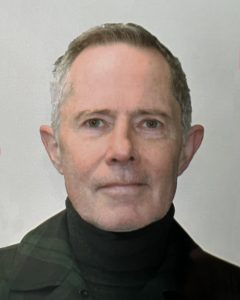
Every local council wants the best outcomes for their community, but knowing what that might look like and how to deliver them, can be a challenging task. ONH’s Brendan Talk O’Neill discusses how their approach to an understanding of place can provide a starting point for identifying and delivering opportunities for positive change.
Profile: Brendan is an architect with over thirty years’ experience in the industry.
Before founding ONH he held senior positions in several high profile architectural practices and was responsible for a range of award winning projects across the cultural, residential and commercial sectors.
An early advocate of low energy and environmentally sensitive design he helped develop a new model for the design of office buildings before moving into the residential sector and the masterplanning of settlements.
His experience provides a depth of understanding of the commercial realities of the development world which is important in supporting ONH in its work with Town and Parish Councils helping them figure out how to respond to the opportunities and challenges of planning for change.
ONH: Planning for Good is a small social enterprise working across most of England. The team consists of planners, architects and urban designers. ONH’s team has a strong bond with its social mission: to enable community supported, high-quality and sustainable development, engaging successfully with local communities along the way.

Workshops 1, 2 and 3
- There will be three workshops running during the afternoon session. Each of these are for limited numbers of participants.
- All workshops are running simultaneously you must book onto your preferred workshop in advance of the conference using the links at the top of this page (right hand side).
- Bookings for the FREE workshops are only available to attendees of the conference with a valid event ticket.
Workshop 1 – Finding The Spatial Character of Place – with Tom Sykes, Common Works Architecture
During this workshop we will look at an example village /town and through maps and photos, participants will identify the elements that give it a unique character, and think about how these could guide future development, design guidance and neighbourhood plans.
This workshop is for people who want to get inside the process of understanding the way places evolve. By picking up pens and talking through drawing we’ll work through three micro workshops:
- Building a brief for a place shaping vision
- Analysing a place through maps and photographs
- Using this to imagine the future
Over the hour there will be a mix of tools & techniques, opportunities to make a mess & try things out, and a chance to understand the ways different stakeholders can come together around place shaping.
Led by: Tom Sykes, Director, Common Works Architecture & Mel Woof CEO BMKALC
Workshop 2 – Partnership working between diverse stakeholders – with Will Rysdale MKCC and Delia Shephard Bletchley & Fenny Stratford Town Council
During this workshop we will explore the process and challenges of capturing ideas and ambitions from multiple stakeholders, whilst managing their expectations and ultimately delivering an outline project true to the original sentiments which can be delivered.
Led by: Will Rysdale Head of Housing Delivery and Regeneration, MKCC and Delia Shephard, Clerk, Bletchley & Fenny Stratford Town Council
Workshop 3 –
Spatial Settlement Planning: from Pressure to Prosperity – with Brendan O’Neill, Director, ONH: Planning for Good and Louise Stubbs, former Deputy Town Clerk of Buckingham Town Council, now Business Development & Projects Manager, ONH: Planning for Good
A three stage workshop covering:
Understanding place and pressures for change in your area:
- Identify and discuss national changes that are impacting on planned and speculative development in all areas across the country. Internal and external pressures are pushing a drive to deliver more homes. (Examples, Green Belt/Grey Belt for South Bucks)
- Interactive activity to identify the local challenges the attendees in the room are facing.
Engagement and opportunities:
- What does the community need? What are other drivers for change in the area? How do you move past the least-worst sites approach of a local plan HELAA assessment and identify positive possibilities for change?
- Interactive activity about ways to engage with landowners and the community.
Making choices: how to deliver the change
- What happens next? Options beyond neighbourhood plans, including co-development and representations for the emerging local plans.
- Interactive activity about choosing between options and community involvement.
Q&A
If the number is 1.5 million homes, how can we also hold on to these as individual places where full lives happen? Where communities grow? That add to our culture? The homes where our memories are made?
Through illustrations Tom will talk about different approaches to making new homes that put the social life of places first. Moving between well tested and grounded examples to innovative and idealistic possibilities there will be ways of adding quality to every situation.
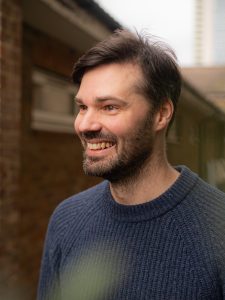
Tom Sykes, founding director, Common Works Architecture
‘Tom inspires people to understand the value and possibilities of design. He brings it to life by showing what it can give to a project – its long standing impact, and the role we all have in shaping that’
At Common Works we design projects for the common good, using architecture to build community and spark a sense of connection. This could mean new housing built around a courtyard to turning derelict railway arches into affordable workspaces, helping a community compost group unlock a site, upgrading a town council office into a working hub with communities at its heart or retrofitting a learning kitchen into a museum.
Director Tom has previously held leadership roles in client side organisations, building up a particular understanding of development and design, grounding the aspirational work of the practice into realisable and realistic projects. Setting up the practice creates the opportunity to share this client side knowledge, supporting community organisations and public sector clients to shape better places – places that put people first.
Advocacy
Tom is an Expert for the Design Council, a Public Practice Alumni, a training lead at Urban Design Learning, sits on several Design Review Panels and teaches at the Welsh School of Architecture.
Contact:
The Chalk, Cherries and Chairs Landscape Partnership Scheme has been running since 2019 and will wrap-up in November 2024. The Scheme was set up to face the challenges to the Central Chilterns of the day: the development of HS2; the loss and fragmentation of ancient woodland and other wildlife habitats through development; the disappearance of traditional orchards and hedgerows; and an increasing disconnect between people and their local landscape.
Funded primarily by the National Lottery Heritage Fund, the Scheme has worked across three themes – wildlife, heritage and people. Under these themes, a whole host of projects interweaving topics such as volunteering, engagement, research, restoration and enhancement in order to deliver tangible, on-the-ground benefits and a lasting legacy for our landscape. We have created a Farmer Cluster to bring people together to care for wildlife, increased and expanded wildlife monitoring, fostered partnership working, and helped people to take action for wildlife and heritage within the Chilterns, whether through volunteering, community planning, or simply enjoying the landscape through walks, talks and events.
As we celebrate the work we have done, achievements made and lessons learned, we’d like to take this chance to encourage you to keep taking action and don’t stop doing what you’re doing! We want our legacy and your input to continue far into the future. You may be a partner looking to take on aspects of our projects, a community group now up-and running and able to work independently, or you may just be interested in learning more about the nature around you and conserving your landscape. Whatever your motivation, wildlife and heritage need you! Read some ideas about how to get involved and what support is available at https://www.chilterns.org.uk/chalkcherrieschairs/ccc-legacy/

The Chilterns National Landscape is a designated Area of Outstanding Natural Beauty – an area of land that is of national importance for its natural beauty and special qualities, including geology, wildlife, landscape features, and rich cultural history. National Landscapes have the same level of landscape quality and the same level of protection as National Parks.
The Chilterns National Landscape is a designated Area of Outstanding Natural Beauty – an area of land that is of national importance for its natural beauty and special qualities, including geology, wildlife, landscape features, and rich cultural history. National Landscapes have the same level of landscape quality and the same level of protection as National Parks.

Wild Amersham @Sustainable Amersham aims to engage local people to appreciate, protect and restore local nature. We do this through organising events about nature, helping to manage three local sites for nature, and monitoring changes in biodiversity in Amersham and Chesham Bois. If you would like to know more, go to our website (https://sustainableamersham.org/wild-amersham/), check us out on instagram @sustainableamersham and #wildamersham, or come to one of our events. You can sign up for the Sustainable Amersham monthly email newsletter via https://sustainableamersham.org/join-sustainable-amersham/ and for the quarterly Wild Amersham email via: https://forms.gle/5rboVRQ3bp4znEdr6.
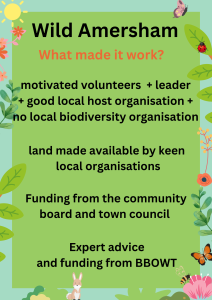
House Martin Conservation UK & Ireland is a newly formed conservation charity covering the UK and Ireland dedicated to the care and protection of the house martin.
House martin numbers have been in decline for many years with a UK & Ireland conservation status of ‘Red’. The charity aims to encourage as many people as possible to come together and raise awareness in communities that this special bird of the hirundine family needs our help, and encourage communities to take action to improve nesting opportunities for house martins. The aim is to halt and hopefully reverse their decline in numbers.
We are the Natural Environment Partnership, which is the Local Nature Partnership for Buckinghamshire and Milton Keynes. We bring together a diverse range of individuals, businesses and organisations to drive positive change in the local natural environment.
The NEP promotes the value of the natural environment in decision making at all levels and takes a strategic view of the challenges and opportunities facing nature. The NEP is working alongside the Local Enterprise Partnerships (LEPs) and the health and wellbeing boards to embed natural environment in growth, economic & health strategies, and develop interventions and programmes for delivery.
https://bucksmknep.co.uk/nature-strategy/
If you wish to be added to our mailing list, email us at – nep@buckinghamshire.gov.uk
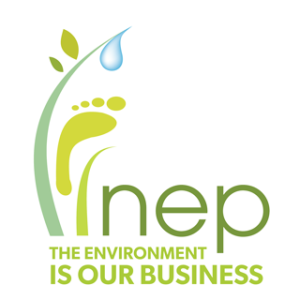
Community WildBelt is a project funded by the National Lottery Heritage Fund to help nature recovery in Wendover and surrounding parishes. We want to connect people with nature where they live. Working with community groups, parish councils, schools and private landowners we can offer practical support, knowledge and small grants. Volunteering is at the heart of the project encouraging people to learn new skills and share with others how important our wildlife is.
https://chilternsociety.org.uk/community-wildbelt/

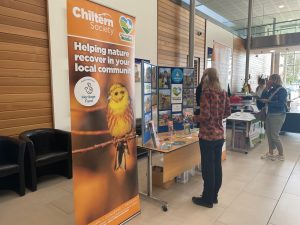
The Chalk, Cherries and Chairs Landscape Partnership Scheme has been running since 2019 and will wrap-up in November 2024. The Scheme was set up to face the challenges to the Central Chilterns of the day: the development of HS2; the loss and fragmentation of ancient woodland and other wildlife habitats through development; the disappearance of traditional orchards and hedgerows; and an increasing disconnect between people and their local landscape.
Funded primarily by the National Lottery Heritage Fund, the Scheme has worked across three themes – wildlife, heritage and people. Under these themes, a whole host of projects interweaving topics such as volunteering, engagement, research, restoration and enhancement in order to deliver tangible, on-the-ground benefits and a lasting legacy for our landscape. We have created a Farmer Cluster to bring people together to care for wildlife, increased and expanded wildlife monitoring, fostered partnership working, and helped people to take action for wildlife and heritage within the Chilterns, whether through volunteering, community planning, or simply enjoying the landscape through walks, talks and events.
As we celebrate the work we have done, achievements made and lessons learned, we’d like to take this chance to encourage you to keep taking action and don’t stop doing what you’re doing! We want our legacy and your input to continue far into the future. You may be a partner looking to take on aspects of our projects, a community group now up-and running and able to work independently, or you may just be interested in learning more about the nature around you and conserving your landscape. Whatever your motivation, wildlife and heritage need you! Read some ideas about how to get involved and what support is available at www.chilterns.org.uk/ccc-legacy

The Diocese of Oxford is committed to working towards net zero carbon by 2035 and, recognising that the climate change and biodiversity loss crises are intricately linked, to encouraging wildlife friendly land management practices on the land under its influence.
We share the following resources relating to churchyards, cemeteries, and church gardens.
https://www.oxford.anglican.org/environment-and-social-justice/environmental-action/biodiversity/
https://www.oxford.anglican.org/xdb/ecohub/show/churchyard-management-plan-examples
We also work with the Berkshire, Buckinghamshire and Oxfordshire Wildlife Trust on Wilder Churches. https://www.bbowt.org.uk/team-wilder/team-wilder-churches
Do add pins for churchyards managed with wildlife in mind on the Team Wilder map. https://www.bbowt.org.uk/be-part-of-team-wilder
The national Church of England Environment Programme shares a number of land and nature resources. https://www.churchofengland.org/about/environment-and-climate-change/land-and-nature
North Bucks Bat Group (NBBG) exists to promote bat conservation in Aylesbury Vale, Milton Keynes and Chiltern Hills through recording, monitoring, education work, practical conservation and by advising the public. NBBG works in partnership with the Bat Conservation Trust and in collaboration with other bat groups.


https://www.northbucksbatgroup.org.uk/

The Upper Thames branch of Butterfly Conservation is a semi-autonomous group of volunteers working to conserve the habitats of butterflies and moths. We are part of that registered charity: England & Wales (254937) Scotland different but hardly relevant.
Founded in 1982, the Upper Thames Branch aims to protect butterflies, moths in the counties of Berkshire, Buckinghamshire and Oxfordshire. We do this through the following actions:
- Thorough recording of all resident and migrant species with both standardised and casual recording methodology
- The sharing of above records
- Habitat assessments and advice on management of sites
- Conservation tasks to assist with our advised management
- Training in survey methodology
- Training in identification of butterflies and moths
- Guided walks and moth trapping events to encourage communities to become aware of and to care for their butterflies and moths
https://www.upperthames-butterflies.org.uk/
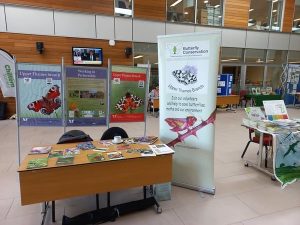
A managed native hedgerow maintains land quality, aids the environment and provides food, shelter and corridors for wildlife. There is a huge opportunity for local councils to get a fast improvement in bio-diversity by properly managing native hedgerows in their public spaces and their community at large.
In early 2023, Chilterns Natural Landscape, through the Chalk, Cherries and Chairs landscape partnership and BBOWT, funded the creation of the Rough around the Hedges team of experienced volunteers. This team trained in hedge management, particularly the heritage art of hedge laying, rejuvenating leggy, gappy and over mature hedgerows to give better bushy and bio-diverse environment. This highly capable and dedicated volunteer group has already successfully delivered successful results on a number of conservation and farm sites.
As Chalk, Cherries and Chairs draws to a close, Rough around the Hedges is transferring to the Chiltern Society in order to continue supporting bio-diversity in the Chilterns and surrounding areas. The Chiltern Society provides the volunteer group with organisational and logistical support including insurance and ongoing training.
Rough around the Hedges is able to provide trained volunteers to lead hedge laying exercises on suitable native hedges and to offer training to local volunteers to enable good future maintenance. Volunteers are free and the incremental material cost is low. Local funding has proved straightforward for client sites to find.
Please direct any enquiry to Paul Heath, via the Chiltern Society at this address.
BBOWT is the only voluntary organisation in the region concerned with all aspects of nature conservation.
We give wildlife a helping hand to ensure it thrives in our three counties. As well as managing our nature reserves, this includes monitoring species and running special projects to support declining species such as water voles, or threatened habitats such as chalk grassland. We also advise other landowners about how to care for habitats and species.

Information about the Council’s ecology team can be found here: Ecology and biodiversity | Buckinghamshire Council
Information about Biodiversity Net Gain can be found here: Biodiversity net gain | Buckinghamshire Council
Information about recording wildlife and Bucks and Milton Keynes Environmental Record Centre (BMERC) can be found here: Wildlife Recording Tips | Buckinghamshire and Milton Keynes Environmental Records (bucksmkerc.org.uk) and here: Make Your Wildlife Observations Count – Biological Recording

Buckinghamshire Council’s Community Boards have a range of priorities including those that champion the natural environment. To find out more and connect with your local Community Board, please visit Community Boards | Buckinghamshire Council
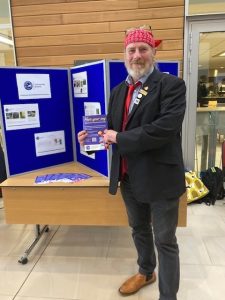
We are the Natural Environment Partnership, which is the Local Nature Partnership for Buckinghamshire and Milton Keynes. We bring together a diverse range of individuals, businesses and organisations to drive positive change in the local natural environment.
The NEP promotes the value of the natural environment in decision making at all levels and takes a strategic view of the challenges and opportunities facing nature. The NEP is working alongside the Local Enterprise Partnerships (LEPs) and the health and wellbeing boards to embed natural environment in growth, economic & health strategies, and develop interventions and programmes for delivery.
We work with our partners at a strategic, landscape-scale to champion the value of the environment. Some of our key publications include:
- Biodiversity Accounting
- Doubling Nature: Strategic-Scale Opportunities Mapping in the Arc
- Forward to 2030: Biodiversity Action Plan
- Green Infrastructure Opportunity Zones
https://bucksmknep.co.uk/nature-strategy/
If you wish to be added to our mailing list, they can email us at – nep@buckinghamshire.gov.uk

Sponsors
